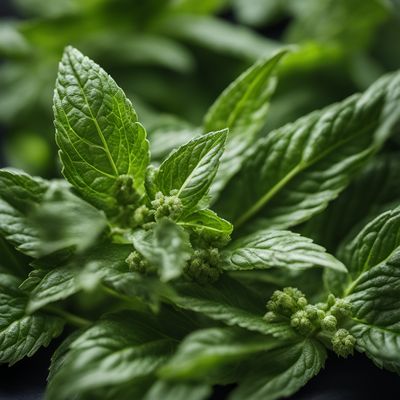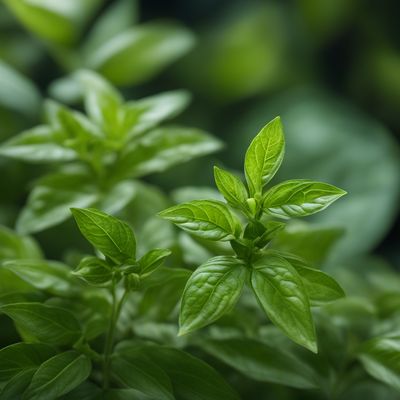
Ingredient
Lesser calamint
The Mediterranean Herb Wonder
Lesser calamint is a perennial herb with small, lance-shaped leaves and delicate purple flowers. It has a distinct minty flavor with hints of oregano and thyme, and its fragrance is reminiscent of a summer meadow. This herb is native to the Mediterranean region and has been used in culinary and medicinal applications for centuries.
Origins and history
Lesser calamint has a long history of use in Mediterranean cuisine, particularly in Italian and Greek dishes. It was highly valued by ancient civilizations, including the Romans and Greeks, for its culinary and medicinal properties. Today, it continues to be a popular herb in Mediterranean cooking and is also enjoyed in herbal teas and infusions.
Nutritional information
Lesser calamint is low in calories and rich in antioxidants, vitamins, and minerals. It contains essential oils that have antimicrobial and anti-inflammatory properties. This herb is also known to aid digestion and promote overall well-being.
Allergens
There are no known allergens associated with lesser calamint.
How to select
When selecting lesser calamint, look for fresh, vibrant leaves that are free from wilting or discoloration. The leaves should have a strong aroma, indicating their freshness and flavor. If purchasing dried lesser calamint, ensure that it is stored in an airtight container to maintain its potency.
Storage recommendations
To store lesser calamint, wrap the fresh leaves in a damp paper towel and place them in a plastic bag in the refrigerator. Alternatively, the leaves can be dried and stored in an airtight container in a cool, dark place. Dried lesser calamint can retain its flavor for up to a year.
How to produce
Lesser calamint can be easily grown in a sunny spot in the garden or in containers. It thrives in well-drained soil and requires regular watering. The plant can be propagated through seeds or cuttings, making it accessible for amateur gardeners.
Preparation tips
Lesser calamint can be used in a variety of dishes, including pasta sauces, roasted vegetables, grilled meats, and soups. It pairs well with tomatoes, olives, and feta cheese, adding a refreshing and aromatic touch to these dishes. Additionally, it can be brewed into a soothing herbal tea or infused into oils and vinegars for added flavor.
Substitutions
Oregano, thyme, or mint can be used as substitutes for lesser calamint. While they may not provide the exact same flavor profile, they can still add a pleasant herbal note to dishes.
Culinary uses
Lesser calamint is commonly used in Mediterranean cuisine, particularly in Italian and Greek dishes. It is often added to pasta sauces, pizzas, and roasted vegetables. Additionally, it is enjoyed in herbal teas and infusions for its aromatic properties.
Availability
Lesser calamint is commonly available in the Mediterranean region, including Italy, Greece, and Turkey. It can also be found in specialty stores or online retailers that offer a wide range of herbs and spices.
More ingredients from this category » Browse all

Hoary basil
The Aromatic Herb: Hoary Basil

Asiatic pennywort
The Healing Herb: Unveiling the Wonders of Asiatic Pennywort

Chinese mesona
The Cooling Elixir

Thai basil
The Fragrant Herb: Thai Basil

Greek bush basil
The Fragrant Herb of the Mediterranean: Greek Bush Basil

Rice paddy herb
The Fragrant Gem

Vietnamese mint
The Zesty Herb

Holy basil
The Sacred Herb: Holy Basil

Mints
The Refreshing Herb

Basil
The King of Herbs

Lemon basil
The Zesty Herb: Unveiling the Delights of Lemon Basil

Lizard tail
The Enigmatic Delicacy: Lizard Tail
Recipes using Lesser calamint » Browse all

Peanut Delight Chutney
Creamy Peanut Chutney: A Nutty Twist to Indian Cuisine

Psilokomeni Salata with Feta and Olives
Mediterranean Delight: Psilokomeni Salata with a Greek Twist

Roasted Eggplant Salad
Smoky Delight: Roasted Eggplant Salad Latvian Style

Bolivian Llama Stew
Andean Delight: Bolivian Llama Stew with Quinoa and Spices

Baltic-style Pickled Vegetables
Baltic Brine: A Tangy Twist on Pickled Vegetables

Filipino-style Stuffed Beef Roll
Savory Beef Delight: A Filipino Stuffed Roll Recipe

Rame di Napoli - Italian Stuffed Rice Balls
Savory Delights: Irresistible Italian Stuffed Rice Balls

Frittata Pasquale Umbra
Easter Delight Frittata: A Traditional Italian Celebration

Grilled Kuzu Şiş with Mediterranean Flavors
Succulent Grilled Lamb Skewers with a Taste of the Mediterranean

Haipai-style Leems
Savory Fusion: Haipai-inspired Leems with a Twist

St. Louis Flamiche
Cheesy St. Louis Flamiche: A Savory Delight with a Local Twist

Croatian Spinach and Hard-Boiled Egg Salad
Savory Delight: Croatian Spinach and Egg Medley